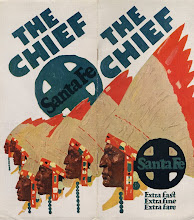At the museum, each visiting class was split up into two groups of twenty to thirty students. Wolfsonian Manager of Youth & School Programs Coordinator, Claudia Caro Sullivan took half of them on a guided tour of the museum galleries, and some of them also participated in an art project involving the creation of a book of self-portraits. The other group was ushered up to the library for a talk about the rise of Adolf Hitler to power in Germany in 1933, and a discussion of the history of racial discrimination in the United States and Germany. The students learned that although the United States was still struggling with segregation, horrific lynchings and KKK terror, Jim Crow laws, and other discriminatory practices, some progress towards civil rights began to be made during the Roosevelt Administration. Ironically, at the same time, Germany’s rather tolerant record as regards Jewish emancipation and assimilation and Jewish-German mixed marriages made an immediate about face as the Nazi regime promoted anti-Semitism and goose-stepped the nation down the path of a racist regime. After the discussions, the students in my group joined Claudia, and those in her group came up to the library.
One of the questions we tried to address during the back-to-back discussions in the library was how Hitler and the National Socialists were able to seize power, exercise dictatorial control, and to perpetrate such a monstrous program as the liquidation of six million Jews and another six million Gypsies, Russians, homosexuals, disabled persons, and a host of political dissidents. The materials laid out on the table suggested that Hitler and his gang recognized the importance of propaganda, for even a dictator needed to maintain at least the appearance of popular support.
Garnering the support of talented graphic artists, photographers, and filmmakers Hitler and his Reich Minister of Propaganda Joseph Goebbels (1897-1945) staged rallies and parades and a paper campaign designed to forge a positive image for himself and his party that belied the hideous program he had in store. Promising work in a time of global depression, a revival of German fortunes after the humiliations of defeat in the catastrophic First World War, Hitler appealed to German patriotism and provided them with a scapegoat aimed at uniting the nation against a common enemy. During the war, the Nazis forced Jews to wear badges to single them out and employed heavy doses of anti-Semitic propaganda to dissuade persons in the occupied territories from sheltering the “enemies” of the Third Reich (like Anne Frank and her family) and to encourage them to turn them in to the Gestapo for deportation to “work camps.”
The bachelor führer was also savvy enough to recognize the importance of posing with youngsters. He also provided propaganda books for the schools and established the Hitler Jugend as a means of brainwashing an entire generation of impressionable youths.
The visiting middle school students, however, were not so easily manipulated by the propaganda. Many perceptively noted the discrepancies between Hitler’s racist rhetoric and reality. As one French caricature from the period made clear, (and as Charlie Chaplin had hilariously pointed out in his brilliant and pointed satire, The Great Dictator), the browned-eyed, brunette leader of the blonde race did not match the Aryan ideals he promoted.
http://www.youtube.com/watch?v=IJOuoyoMhj8
It became obvious from our discussions that it was not possible to determine a person’s race by appearances, and that the horrible stereotypes of Jews the Nazis created as a prelude to the Holocaust were caricatures as absurd as the idea of an Aryan “master race.” If it were so easy to identify Jews, some concluded, why had it have been necessary for the Nazis to force persons of Jewish ancestry to wear badges identifying themselves as such?









No comments:
Post a Comment